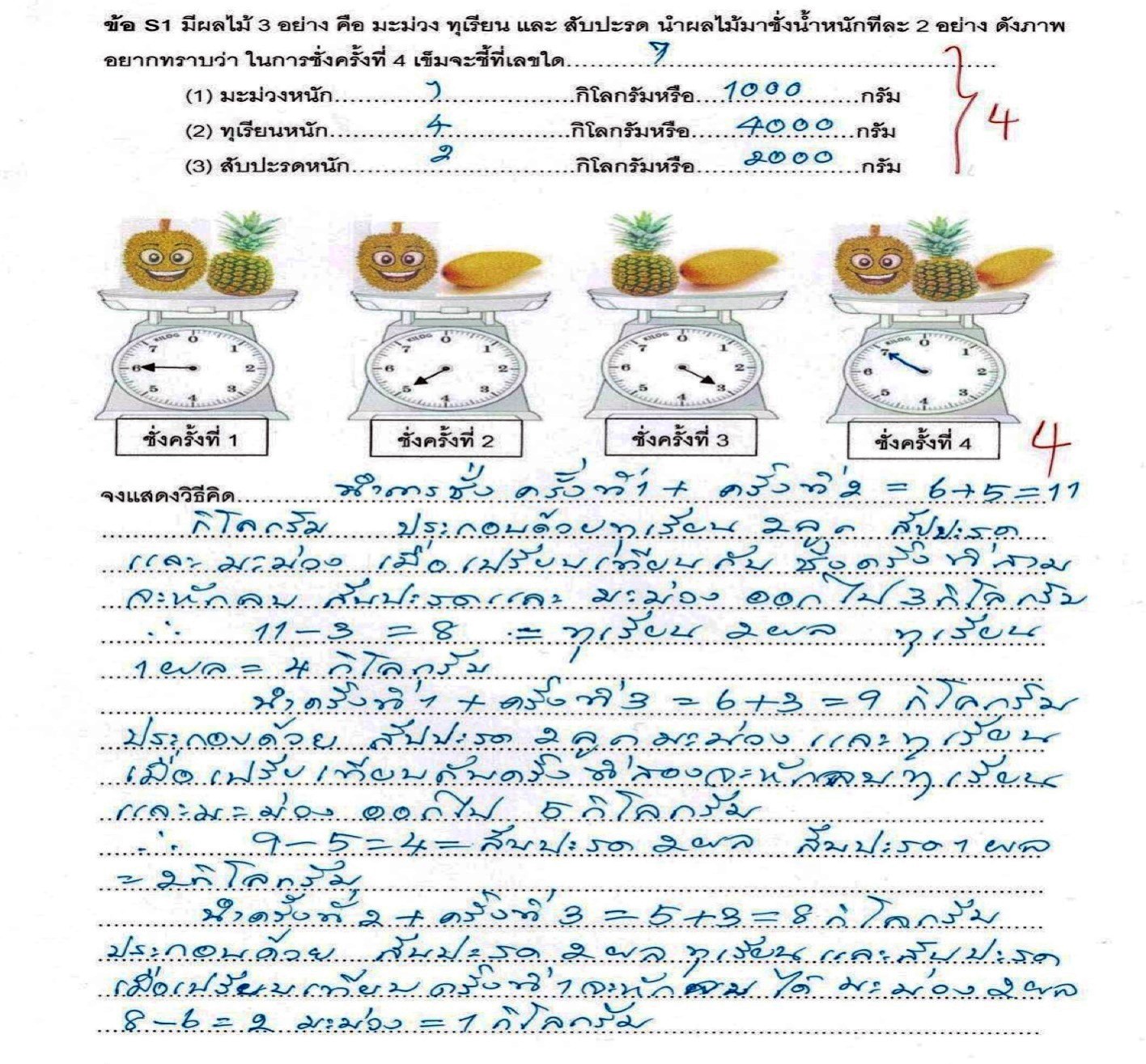การศึกษาระดับความเข้าใจเชิงมโนทัศน์ทางคณิตศาสตร์ เรื่อง การวัดความยาวและการชั่ง ของนักเรียนชั้นประถมศึกษาปีที่ 6
Main Article Content
Abstract
Supphakit Prachumkayohmat, Khwan Piasai, Sukanya Hajisalah and Anek Janjaroon
รับบทความ: 27 พฤษภาคม 2563; แก้ไขบทความ: 9 กรกฎาคม 2563; ยอมรับตีพิมพ์: 24 กรกฎาคม 2563
บทคัดย่อ
งานวิจัยนี้มีวัตถุประสงค์เพื่อศึกษาระดับความเข้าใจเชิงมโนทัศน์ทางคณิตศาสตร์ เรื่อง การวัดความยาวและการชั่งของนักเรียนชั้นประถมศึกษาปีที่ 6 ตามกรอบทฤษฎี APOS และจัดกลุ่มระดับความเข้าใจเชิงมโนทัศน์ทางคณิตศาสตร์ เรื่อง การวัดความยาวและการชั่ง ตามกรอบทฤษฎี APOS ของนักเรียนชั้นประถมศึกษาปีที่ 6 ที่มีผลสัมฤทธิ์ทางการเรียนคณิตศาสตร์ที่แตกต่างกัน นักเรียนกลุ่มที่ศึกษาเป็นนักเรียนชั้นประถมศึกษาปีที่ 6 จำนวน 40 คน ของโรงเรียนแห่งหนึ่ง โดยเลือกแบบจำเพาะเจาะจงอย่างมีจุดมุ่งหมาย เครื่องมือที่ใช้ในการวิจัยในครั้งนี้ ได้แก่ แบบทดสอบวัดผลสัมฤทธิ์ทางการเรียนคณิตศาสตร์ เรื่อง การวัดความยาวและการชั่ง เป็นแบบทดสอบปรนัยชนิดเลือกตอบ 4 ตัวเลือก จำนวน 30 ข้อ และงานปฏิบัติ เรื่อง การวัดความยาวและการชั่ง เป็นแบบทดสอบอัตนัยจำนวน 46 ข้อ ที่สร้างขึ้นตามกรอบทฤษฎี APOS การเก็บรวบรวมข้อมูลเริ่มจากให้นักเรียนกลุ่มที่ศึกษาทำแบบทดสอบวัดผลสัมฤทธิ์ทางการเรียนคณิตศาสตร์ เรื่อง การวัดความยาวและการชั่ง จากนั้นแบ่งนักเรียนเป็น 3 กลุ่ม คือ นักเรียนกลุ่มเก่ง กลุ่มปานกลาง และกลุ่มอ่อน โดยพิจารณาคะแนนจากแบบทดสอบวัดผลสัมฤทธิ์ทางการเรียนคณิตศาสตร์ เรื่อง การวัดความยาวและการชั่ง โดยใช้เทคนิค 25% (1:2:1) จากนั้นให้นักเรียนแต่ละกลุ่มดังกล่าวทำงานปฏิบัติเพื่อพิจารณาคะแนนและจัดกลุ่มระดับความเข้าใจเชิงมโนทัศน์ทางคณิตศาสตร์ เรื่อง การวัดความยาวและการชั่ง ซึ่งการวิจัยนี้จัดกลุ่มระดับความเข้าใจเชิงมโนทัศน์ทางคณิตศาสตร์เป็น 4 กลุ่ม ได้แก่ กลุ่ม A AP APO และ APOS ผลของระดับความเข้าใจเชิงมโนทัศน์ทางคณิตศาสตร์ พบว่า เนื้อหาเรื่อง การวัดความยาว คะแนนระดับการกระทำ (A) มีค่าเฉลี่ยคิดเป็นร้อยละ 75.95 คะแนนระดับกระบวนการ (P) มีค่าเฉลี่ยคิดเป็นร้อยละ 71.08 คะแนนระดับสิ่งที่เรียนรู้ (O) มีค่าเฉลี่ยคิดเป็นร้อยละ 51.88 และคะแนนระดับแผนภาพทางปัญญา (S) มีค่าเฉลี่ยคิดเป็นร้อยละ 62.50 สำหรับเนื้อหาเรื่อง การชั่ง คะแนนระดับการกระทำ (A) มีค่าเฉลี่ยคิดเป็นร้อยละ 86.20 คะแนนระดับกระบวนการ (P) มีค่าเฉลี่ยคิดเป็นร้อยละ 65.55 คะแนนระดับสิ่งที่เรียนรู้ (O) มีค่าเฉลี่ยคิดเป็นร้อยละ 83.93 และคะแนนระดับแผนภาพทางปัญญา (S) มีค่าเฉลี่ยคิดเป็นร้อยละ 63.43 ผลของการจัดกลุ่มระดับความเข้าใจเชิงมโนทัศน์ทางคณิตศาสตร์ พบว่า นักเรียนกลุ่มเก่งอยู่ในกลุ่มระดับความเข้าใจเชิงมโนทัศน์ทางคณิตศาสตร์ กลุ่ม APOS จำนวน 2 คนกลุ่ม APO จำนวน 4 คน กลุ่ม AP จำนวน 2 คน และกลุ่ม A จำนวน 2 คน รวมทั้งหมด 10 คน นักเรียนกลุ่มปานกลางอยู่ในกลุ่มระดับความเข้าใจเชิงมโนทัศน์ทางคณิตศาสตร์ กลุ่ม APO จำนวน 1 คน กลุ่ม AP จำนวน 1 คน กลุ่ม A จำนวน 9 คน และไม่ผ่านเกณฑ์จำนวน 9 คน รวมทั้งหมด 20 คน และนักเรียนกลุ่มอ่อนอยู่ในกลุ่มระดับความเข้าใจเชิงมโนทัศน์ทางคณิตศาสตร์ กลุ่ม A จำนวน 4 คน และไม่ผ่านเกณฑ์จำนวน 6 คน รวมทั้งหมด 10 คน
คำสำคัญ: ระดับความเข้าใจเชิงมโนทัศน์ทางคณิตศาสตร์ ทฤษฎี APOS ผลสัมฤทธิ์ทางการเรียนคณิตศาสตร์ การวัดความยาวและการชั่ง
Abstract
This research aimed to study the levels of mathematical conceptual understanding on measurements of length and weight among grade–six students, to categorize levels of mathe-matical conceptual understanding on measurements of length and weight, and followed APOS theory among grade–six students with different levels of mathematical proficiency. The study student groups were identified and selected with a specific purpose. The tools used in the research were as follows: a four choice multiple–choice mathematical proficiency test, with 40 questions on measurements of length and weight; and a task on the measurements of length and weight in from of a subjective test with 46 questions, created with the APOS theory framework. Regarding the data collection process; the students took a mathematical pro-ficiency test on the measurements of length and weight, then divided into three groups, namely, top-level, middle–level, and low-level scores, considering the test scores applied the 25% technique (1:2:1). Later, the students in each group were given a task on measurements of length and weight, consisting of four levels on a conceptual understanding of mathematical concepts, following the APOS theory framework, namely, A, AP, APO and APOS. The results of measurements of length showed the mean score of the action level was 75.95%, the process level was 71.08%, the object level was 51.88%, and the schema level was 62.50%. For measurements of weight, it was found that the mean score at the action level was 86.20%, the process level was 65.55%, the object level was 83.93%, and at a schema level of 63.43%. Following the aforementioned data, the students demonstrated different levels of mathematical conceptual understanding. As a result of the categorization, it was found that in the top–level score group, which consisted of 10 students; two demonstrated a conceptual understanding of mathematical concepts at the APOS level, four at the APO level, two at the AP level, and two at the A level. The middle–level score group consisted of 20 students in total, and there was one at the APO level, one at the AP level, and nine at the A level, with the other nine students failing to reach any levels. Within the low–level score group, which consisted of 10 students, four demonstrated a conceptual understanding at an A level, while the other six students failed to reach any level.
Keywords: Level of mathematical conceptual understanding, APOS theory, Mathematics achievement, Measurements of length and weight
Downloads
Article Details

This work is licensed under a Creative Commons Attribution-NonCommercial 4.0 International License.
References
Damsubhan, V. (2015). Conception and Study of Mathematical Understanding. Bangkok: Danax Intercopration. (in Thai)
Dubinsky, E. (1991). Reflective abstraction in advance mathematical thinking. In Tall, D. O. (Ed.), Advance Mathematical Thinking (pp. 95–123). Dordrecht: Kluwer.
Dubinsky, E., Weller, K., McDonald, M. A., and Brown, A. (2005). Some historical issues and paradoxes regarding the concept of infinity: An APOS analysis: Part 1. Educational Studies in Mathematics 58: 335–359.
Inprasitha, M. (2014). Problem Solving in School Mathematics. KhonKaen: Pen Printing. (in Thai)
Jamwan, S. (2016). Level of Mathematical Understanding on Symmetry Axis Based on APOS Theory: A Case Study of Grade 4 Huanasuksawit School. Retrieved from https://drive.google.com/file/d/0B2vZpkob4eWgVzNzVFNCRmtaSm8/view, March 5, 2020. (in Thai)
Makhanong, A. (2003). Collection of Articles and Directives on Learning Management, The Learning Outcomes of Mathematics Subject Group. Bangkok: Bophidhkanphim. (in Thai)
Naklamthong, S. (2016). An Investigation of Levels of Mathematical Understanding on Limit Concept Based on APOS Theory Using the Geometer’s Sketchpad (GSP) as Learning Tool. Master’s Thesis in Mathematics Education. KhonKaen: KhonKaen University. (in Thai)
National Council of Teachers of Mathematics. (2000). Principles and Standards for School Mathematics. Reston, VA: NCTM.
National Institute of Educational Testing Service (Public Organization). (2019). Summary of Ordinary National Educational Test (O–NET) Academic Year 2019. Retrieved from http://www.newonetresult. niets.or.th/AnnouncementWeb/PDF/SummaryONETP6_2561.pdf, March 1, 2020. (in Thai)
National Measurement Office. (2017). Measurement in Daily Life. Retrieved from https://www.npl.co.uk/upload/pdf/measure ment-matters.pdf, March 5, 2020.
Nawaphan, N. (2013). Academic Article. Retrieved from http://pookpikschool.com/Learn/vichakarn.pdf, June 28, 2020. (in Thai)
Ruangsawat, P. (2019). Development of Learning Management Model Based on Con-structivist Theory to Promote Mathematical Understanding in Probability of Mathayomsuksa 5 students. Master’s Thesis in Mathematics and Mathematics Education. Phatthalung: Thaksin University. (in Thai)
Sethachan, P. (2013). A Study of Learning Achievement and Attitudes toward Mathematics for Measuring Length and Weight of Grade 3 Students with Games Learning. Master’s Project, M.Ed. (Elementary Education). Bangkok: Srinakharinwirot University. (in Thai)
Sierpinska, A. (1990). Some Remarks on Understanding in Mathematics. For the Learning of Mathematics 10(3): 24–36.
Thada, J. (2009). Diagnosing of Undergraduate Students’ Mathematical Learning Difficulties on Introduction to Graph Theory in Faculty of Education, KhonKaen University. Master’s Thesis in Mathematics Education. KhonKaen: KhonKaen University. (in Thai)
